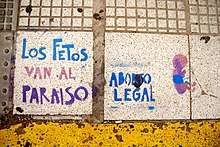Abortion in Venezuela
Any surgical or medicinal method of termination of a pregnancy can be classified as an induced abortion.[1] The Latin American/Caribbean region holds one of the highest rates of induced abortion in the world; it is calculated that for every 1,000 live births, there are just over 300 abortions, many of which are illegal and/or clandestine abortions. [2] A clandestine abortion is one that is not performed under proper medical care or safe conditions. Since abortion is illegal in Venezuela, a clandestne procedure is often the only choice that a woman has in terminating an unwanted pregnancy, unless she is faced with certain conditions. Venezuela's policy on abortion follows the "indications model," meaning that it is permissible only when the pregnancy is a threat to the health of the pregnant woman, it is a result of rape, or the fetus cannot live outside of the womb.[3] The punishment for a woman who has an abortion for any other reason is a prison sentence lasting anywhere between six months and two years. While the punishment for a doctor or any person who performs the procedure is between one and three years, harsher penalties may apply if the pregnant woman dies as a result of the procedure.[4]
Hugo Chavez & Response
Religious Influence on Policy
The population of Venezuela is almost three-quarters Roman Catholic,[5] making Catholic norms prevalent in Venezuelan society. Abortion laws are debated by those with Catholic beliefs, as some Catholics hold that ‘artificial’ forms of birth control (abortion, condoms, or birth control pills) do not align with the Catholic moral code, and “that abortion is a result of widespread immorality and ignorance.”[6] Protests against abortion-restrictive laws have raised concern for the Catholic community; in May 2006, Pope Benedict XVI met with President Hugo Chavez to discuss his concern over the possibility that Chavez would loosen abortion laws in Venezuela.[7]
Social Activism
During his presidency, Hugo Chavez operated Venezuela under a socialist economy, which was meant to promote equality. Some groups, such as the Feminists in Free and Direct Action for Safe Abortions in Revolution, were formed during his presidency. This group, along with many others, advocates for ending dangerous clandestine abortion.[8] Similarly, Venezuela’s National Constituent Assembly (ANC), formed in July of 2017, advocates for the reformation of Venezuela’s constitution to include women's right to abort beyond those outlined by the “indications model.” [9]
Other efforts to support the movement include “Safe Abortion Information Hotlines…with the goal of informing women via telephone about how to have an abortion using misoprostol.”[10] Misoprostol is a drug that can be used to induce labor and cause a medical abortion, which is any abortion done via drug.[11][12] This hotline provides women with the ability to make an informed decision about proceeding with an abortion. It does not, however, change the legal status of abortion in Venezuela, nor does it provide women access to medical care. Due to abortion’s legal status, Venezuelans often obtain misoprostol through the black market, which is expensive and does not provide medical care. Misoprostol, though it is among the safer forms of clandestine abortion, can be dangerous if not taken under medical supervision. It may cause hemorrhaging and other adverse effects such as infection.[13] If left untreated, it could lead to death. It is estimated that around 6,000 women die every year in Latin America alone because of unsafe abortions.[14] Unsafe abortions contribute significantly to maternal and overall female mortality in Venezuela.
Abortion in South America

References
- ↑ "Frequently Asked Questions". Women's Health Care Physicians. The American College of Obstetricians & Gynecologists. Retrieved 3 October 2018.
- ↑ Paxman, John; Rizo, Alberto; Brown, Laura; Benson, Janie (Aug 1993). "The clandestine epidemic: the practice of unsafe abortion in Latin America" (PDF). Studies in Family Planning. 24 (4): 205–226. Retrieved 3 October 2018.
- ↑ Drovetta, Raquel Irene (27 July 2015). "Safe abortion information hotlines: An effective strategy for increasing women's access to safe abortions in Latin America". Reproductive Health Matters. 23 (45): 47–57. doi:10.1016/j.rhm.2015.06.004. Retrieved 3 October 2018.
- ↑ https://www.un.org/esa/population/publications/abortion/doc/venezuela.doc
- ↑ "Catholicism in Latin America". 5 Facts for Pope Francis's Visit to South America. Pew Research Center. Retrieved 4 October 2018.
- ↑ Capozza, Korey (December 1998). "Clandestine Abortion Kills Latin American Women" (PDF). Off Our Backs. 28 (11): 12–13. Retrieved 4 October 2018.
- ↑ Fisher, Ian (12 May 2006). "World Briefing: Americas: Venezuela: Pope Takes on Chavez". The New York Times. Retrieved 3 October 2018.
- ↑ Drovetta, Raquel Irene (27 July 2015). "Safe abortion information hotlines: An effective strategy for increasing women's access to safe abortions in Latin America". Reproductive Health Matters. 23 (45): 47–57. doi:10.1016/j.rhm.2015.06.004. Retrieved 3 October 2018.
- ↑ Fuentes, Federico (21 June 2018). "Venezuela: Activists demand new constitution enshrine abortion, sexual rights" (1185). Green Left Weekly. Retrieved 11 September 2018.
- ↑ Drovetta, Raquel Irene (27 July 2015). "Safe abortion information hotlines: An effective strategy for increasing women's access to safe abortions in Latin America". Reproductive Health Matters. 23 (45): 47–57. doi:10.1016/j.rhm.2015.06.004. Retrieved 3 October 2018.
- ↑ Allen, Rebecca; O'Brien, Barbara (Summer 2009). "Uses of Misoprostol in Obstetrics and Gynecology". Reviews in Obstetrics & Gynecology. 2 (3): 159–168. PMID 19826573. Retrieved 3 October 2018.
- ↑ "Medical Abortion". Mayo Clinic. Mayo Clinic. Retrieved 3 October 2018.
- ↑ Barbarani, Sofia (25 October 2016). "Illegal abortion is killing horrifying numbers of women in Venezuela - here's why". The Telegraph. Retrieved 3 October 2018.
- ↑ Capozza, Korey (December 1998). "Clandestine Abortion Kills Latin American Women" (PDF). Off Our Backs. 28 (11): 12–13. Retrieved 3 October 2018.
See also
- Abortion
- Abortion by country
- Abortion law